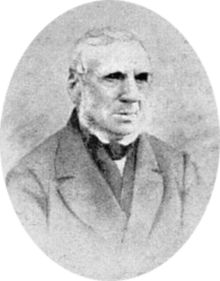James FitzGibbon
| James FitzGibbon | |
|---|---|
 | |
| Born |
16 November 1780 Glin, County Limerick, Ireland |
| Died |
10 December 1863 (aged 83) London, United Kingdom |
| Allegiance |
Great Britain United Kingdom |
| Service/ | British Army |
| Years of service | 1795–1825 |
| Rank | Captain |
| Battles/wars | War of 1812 |
James FitzGibbon (16 November 1780 – 10 December 1863) was a British soldier in the War of 1812.[1]
Biography
Born to Garrett (Gerald) FitzGibbon and Mary Widenham in Glin, County Limerick, Ireland, he enlisted in the Knight of Glin's Yeomanry Corps at age 15.[2] Three years later, he joined the Tarbert Infantry Fencibles, an Irish home service regiment, from which he was recruited into the British Army's 49th Regiment of Foot as a private soldier.[3] He first fought in battle in 1799 at Egmond aan Zee, the Netherlands. He later served as a marine in the Battle of Copenhagen, for which he received the Naval General Service Medal.
He went to Canada in 1802, by which time he was a sergeant. He played a key role in the suppression of a near-mutiny at Fort George, Ontario. In 1806, when he was the regiment's Sergeant-Major, his commanding officer, Isaac Brock, made him an officer. This was extremely unusual at the time as most officers' commissions were bought. Later the same year he was appointed regimental adjutant. In 1809, he was promoted to the rank of Lieutenant.
FitzGibbon fought at the Battle of Stoney Creek on 6 June 1813. Three weeks later, he led 50 soldiers in guerrilla-style raids on a large American force that had captured Fort George on the Niagara Peninsula. It was he who was warned by Laura Secord on 22 June about an impending surprise attack by 500 American troops.[4] This led to the Battle of Beaver Dams near present-day Thorold, Ontario, where FitzGibbon's force, together with about 400 Mohawk and Odawa warriors, defeated the Americans and took 462 prisoners. The victory made FitzGibbon a popular hero and he was promoted to Captain in the Glengarry Light Infantry Fencibles.
In 1814 he fought at the Battle of Lundy's Lane. After the war, he remained in Upper Canada and became a public servant and a colonel in the militia. During the Upper Canada Rebellion of 1837, FitzGibbon was appointed Acting Adjutant-General of Militia. He organised and led the forces that defended Toronto from William Lyon Mackenzie's rebel force.[2]
A Freemason, from 1822 to 1826, he was deputy provincial grand master, the highest office in Upper Canada. He moved to England in 1847 after the death of his wife Mary Haley, with whom he had four sons and a daughter. In 1850 he was appointed a Military Knight of Windsor.
He died at Windsor Castle in 1863 and is buried there in the crypt of St. George's Chapel.
In 2003 his descendants donated some of his personal effects, including a signet ring and a ceremonial sword, to the Canadian War Museum in Ottawa.
In popular culture
FitzGibbon appears in The Bully Boys, a novel by Eric Walters.[5] The book follows his interactions with fictional character Tom Roberts, whom he takes under his wing during the events surrounding the Battle of Beaver Dams.
References
- ↑ Ridler, Jason. "James FitzGibbon". The Canadian Encyclopedia. Retrieved 2017-05-08.
- 1 2 "McKenzie, Ruth. FITZGIBBON, JAMES, Dictionary of Canadian Biography". Retrieved 23 July 2010.
- ↑ Villemaire, Tom; Network, Special to Postmedia. "An outstanding soldier, but his career cost him". Toronto Sun. Retrieved 2017-05-08.
- ↑ "McKenzie, Ruth. INGERSOLL, LAURA (Secord), Dictionary of Canadian Biography". Retrieved 8 June 2010.
- ↑ "The Bully Boys". Eric Walters. Retrieved 2017-04-21.